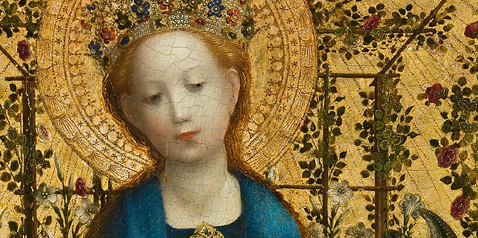
STEFAN LOCHNER
Stefan Lochner, the most famous exponent of medieval painting in Cologne, was probably born around 1400 as the scion of a family of smiths in Hagnau on Lake Constance. He was however more strongly influenced by the art of the Netherlands than by the artists of his native region, and in particular by the work of Robert Campin and the van Eyck bothers, whose Ghent Altarpiece he probably saw shortly after its completion in 1432.
He brilliantly combined ingenious pictorial geometry, the amazingly realistic depiction of a wide variety of materials, the design of architectural backgrounds and the naturalistic representation of the human anatomy (which he was able to study in Flanders) with the charm and mystical animation of the Cologne painting tradition, as represented, for example, by the ‘Master of St Veronica’ or the ‘Elder Master of the Holy Kinship’.
Master painter and city councillor
The first record of Stefan Lochner’s presence in Cologne in the late Middle Ages dates from 1442, when he carried out decorative work in connexion with the visit of the future Emperor Frederick III. Two years later he acquired, at considerable expense, the prestigious pair of houses named ‘Zum alten Grin’ and ‘Zum (kleinen) Karfunkel’. The property was located at the corner of Quatermarkt and In der Höhle, and hence along the same axis as the painters’ houses in Schildergasse, while at the same time close by the centre of power in Cologne, the Rathaus or city hall. In 1447 Lochner became a freeman of the city, because he had prospects of being elected to the city council at Christmas that year as representative of the painters’ guild. At council sessions, which were held on Monday, Wednesday and Friday mornings in the ‘Senatssaal’ on the first floor of the recently completed Rathaus, Lochner may have been able to gaze upon one of his own works, for the Last Judgement, dating from about 1435 (Wallraf-Richartz Museum & Fondation Corboud), was probably placed between the windows on the north wall, above the seats of the two mayors. As Stefan Lochner became a councillor once again in 1450 after the customary two-year break, he looked not only like a successful artist, but an up-and-coming politician too. However, just a few months later this spectacular artistic career came to an abrupt end: in 1451 he, like more than 20,000 others in Cologne, succumbed to the plague.
From the name to the œuvre
None of Lochner’s works is signed, not even the famous Madonna of the Rose Bower. The name Lochner would doubtless have fallen into total oblivion had not his fellow artist Albrecht Dürer, while passing through Cologne in 1520, noted that he had paid a tip to someone to open up a panel by ‘Master Stefan’. Since 1823 this note by Dürer has been related to the so-called ‘Cathedral Picture’, in other words the Altarpiece of the City Patron Saints, which was originally in the council chapel. An identification was made between the ‘Master Stefan’ noted by Dürer and the painter Stefan Lochner, who can be shown to have been living in Cologne, and stylistic comparisons with the ‘Cathedral Picture’ were adduced to assemble an œuvre attributable to him. In 1986 the New York art historian Michael Wolfson reminded us all of the hypothetical character of this reconstruction, but the name Stefan Lochner is still synonymous throughout the world with the quality and charisma of late-medieval painting in Cologne.


